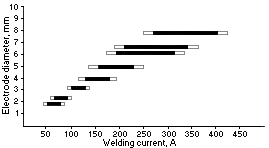

Manual metal arc welding (MMA or MMAW,SMAW, STICK- WELDING), also known as shielded metal arc welding (SMAW), flux shielded arc welding or stick welding, is a process where the arc is struck between an electrode flux coated metal rod and the work piece. Both the rod and the surface of the work piece melt to create a weld.
When an arc is struck between the metal rod (electrode) and the workpiece, both the rod and workpiece surface melt to form a weld pool of molten metal. Simultaneous melting of the flux coating on the rod will form gas and slag which protects the weld pool from the surrounding atmosphere. The slag will solidify and cool and must be chipped off the weld bead once the weld run is complete (or before the next weld pass is deposited).
The process allows only short lengths of weld to be produced before a new electrode needs to be inserted in the welding electrode holder. Weld penetration is low and the quality of the finished weld deposit is highly dependent on the skill of the welder.
To strike an arc between the electrode and base metal, such as carbon steel, and to produce a good quality weld, a stick welder must ensure that their welding machines are fitted with suitable electrodes. Arc stability, depth of penetration, metal deposition rate and positional capability are greatly influenced by the chemical composition of the flux coating on the electrode. Electrodes can be divided into three main groups:
Cellulosic electrodes contain a high proportion of cellulose in the coating and are characterised by a deeply penetrating arc and a rapid burn-off rate giving high welding speeds. Weld deposit can be coarse and with fluid slag, deslagging can be difficult. These electrodes are easy to use in any position and are noted for their use in the ‘stovepipe’ welding technique.
Features:
Rutile electrodes contain a high proportion of titanium oxide (rutile) in the coating. Titanium oxide promotes easy arc ignition, smooth arc operation and low spatter. These electrodes are general purpose electrodes with good welding properties. They can be used with AC and DC power sources and in all positions. The electrodes are especially suitable for welding fillet joints in the horizontal/vertical (H/V) position.
Features:
Basic electrodes contain a high proportion of calcium carbonate (limestone) and calcium fluoride (fluorspar) in the coating. This makes their slag coating more fluid than rutile coatings – this is also fast-freezing which assists welding in the vertical and overhead position. These electrodes are used for welding medium and heavy section fabrications where higher weld quality, good mechanical properties and resistance to cracking (due to high restraint) are required.
Features:
Metal powder electrodes contain an addition of metal powder to the flux coating to increase the maximum permissible welding current level. Thus, for a given electrode size, the metal deposition rate and efficiency (percentage of the metal deposited) are increased compared with an electrode containing no iron powder in the coating. The slag is normally easily removed. Iron powder electrodes are mainly used in the flat and H/V positions to take advantage of the higher deposition rates. Efficiencies as high as 130 to 140% can be achieved for rutile and basic electrodes without marked deterioration of the arcing characteristics but the arc tends to be less forceful which reduces bead penetration.
Electrodes can be operated with AC and DC power supplies. Not all DC electrodes can be operated on AC power sources, however AC electrodes may be used on either AC or DC.

Welding current level is determined by the size of electrode – the normal operating range and current are recommended by manufacturers. Typical operating ranges for a selection of electrode sizes are illustrated in the table. As a rule of thumb when selecting a suitable current level, an electrode will require about 40A per millimetre (diameter). Therefore, the preferred current level for a 4mm diameter electrode would be 160A, but the acceptable operating range is 140 to 180A.

Tunaak Metals Nigeria Limited is a structural steel prefabrication company, which specializes in fabrication of all type of structures, ranging from storage tanks, industrial and marine pipping and miscellaneous steel structures in the civil, industrial and marine sectors. With innovative ideas in steel fabrication we build world class products for a better community. We provide essential and specialize training for our staff to enable us go beyond the expectations of our clients, while implementing adequate safety measures which protects the environment and persons.